Servicios Personalizados
Articulo
Indicadores
Links relacionados
-
 Citado por Google
Citado por Google -
 Similares en Google
Similares en Google
Compartir
Acta Theologica
versión On-line ISSN 2309-9089
versión impresa ISSN 1015-8758
Acta theol. vol.35 no.1 Bloemfontein 2015
http://dx.doi.org/10.4314/actat.v35i1.5
In search of the original text in Mark 9:38
W.M.A. Hendriks
e-mail: wmahendriks@outlook.com
ABSTRACT
The text-critical situation of Mark 9:38 is very complicated. This complex situation already becomes evident in the different readings of the critical editions. While there is almost no variation in the first part of the verse, the critical editions offer four different readings in the last part of it. So there is until now no consensus at all. The question remains which text appears to be the more original one. Several scholars - such as Vaganay, Duplacy, Amphoux, and others - in search of the original text of Mark - opt for a so called Western text, the main stream still prefers the Neutral text of Westcott and Hort. A text-critical analysis of Mark 9:38 may provide an answer to this question.
Keywords: Gospel of Mark, Textual criticism, Fenton Hort, Priority Western text
Trefwoorde: Evangelie volgens Markus, Teks kritiek, Fenton Hort, Voorkeur Westerse teks
1. COMPLICATED TEXT-CRITICAL SITUATION
The story of the strange exorcist in Mark 9:38-40 according to N28 runs as follows: εφη αυτω ο ιωαννησ· διδάσκαλε, ειδομεν τίνα εν τω ονόματι σου εκβαλλοντα δαιμόνια και εκωλυομεν αυτον, οτι ουκ ηκολουθει ημιν. ο δε ιησουσ ειπεν· μη κωλύετε αυτον. ουδεισ γαρ εστιν οσ ποιησει δυναμιν επι τω ονοματι μου και δυνησεται ταχυ κακολογησαι με· οσ γαρ ουκ εστιν καθ ημων, υπερ ημων εστιν, John said to him: "Teacher, we saw someone in your name driving out demons and we tried to stop him, because he was not following us." Jesus said: "Do not stop him. For no one who will do a deed of power on my name will quickly be able to speak evil of me. Indeed, who is not against us, is for us."
The text-critical situation of verse 38 is very complicated. In the words of Dieter Lührmann (1987:166): "Textkritisch ist der Vers auBergewöhnlich kompliziert, ohne daB daran viel für sein Verständnis hángt." This complex situation already becomes evident in the different readings of the critical editions. While there is almost no variation in the first part of the words of John (διδάσκαλε ... εκβαλλοντα δαιμόνια), the critical editions offer four different readings in the last part of the verse. So there is no consensus at all.
The margin of W&H follows D with οσ ουκ ακολουθεί μεθ ημων και εκωλυομεν αυτον, Tis7 Sod Bov Sou BOC HGr follow λ with οσ ουκ ακολουθεί ημιν και εκωλυομεν αυτον, W&H Vog UBS Nol N28 follow N B with και εκωλυομεν αυτον οτι ουκ ηκολουθει ημιν, Tis8 Wss Nes3-25 Mrk with οσ ουκ ακολουθει ημιν και εκωλυομεν αυτον οτι ουκ ηκολουθει ημιν follow in this part of the verse the conflate reading of the Byzantine text (with εκωλυομεν instead of εκωλυσαμεν and ηκολουθει instead of ακολουθει of TR).
2. IN SEARCH OF THE ORIGINAL TEXT
In fact, Hort (1881:120) made it quite clear that the earliest readings which can be fixed chronologically are so called Western readings and that the most widely spread text was the so called Western text. Nevertheless, as is known, Westcott and Hort chose the so called Neutral text as the more original one. The question remains which text appears to be more original. Maybe the Western text? Some indications will be given.
At the Lille colloquium in 2000 I read a paper concerning the textual variation in the Gospel of Mark, illustrated by an analysis of Mark 6:33 (Hendriks 2003). This verse is so to say the cornerstone of the argumentation of Hort in favour of the priority of the text of the codices a and B. Hort (1881:95) divides the readings as follows into three groups: α (called Neutral), και προηλθον αυτουσ of a B, with varations, β (called Western), και συνηλθον αυτου of D 28 b, with varations, and δ (called Syrian), και προηλθον αυτουσ και συνηλθον προσ αυτον of A Π σ ε ω plurimi f q syh eth, with variations. His main point is the conflation of α and β found in δ. However, Hort did not see that και συνηλθον αυτου of D is in fact a duplication of the preceeding συνεδραμον εκει.1The phrase και συνηλθον αυτου seems a marginal note crept into the text. So the following sketch of the transmission of Mark 6:33 has been proposed. Now with the insertion of φ788 as reading 3, according to Lafleur (2013:288) (with ιδων written instead of ειδον). Only the six main types are recorded here.
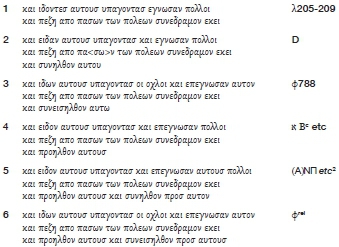
The shorter reading found in λ205-209 is head of the transmission (Ausgangstext).3
In the Revue Biblique I wrote an article with respect to Hort's second example of a conflate reading in the majority text, namely Mark 8:26 (Hendriks 2007). According to Ernst Lohmeyer, the accepted text (Legg 1935, Nes25) of this verse is ununderstandable.4 Very few authors allude to the reading of Codex Bezae D.05 as being head of the transmission.5
υπαγε εισ τον οικον σου και μηδενι ειπησ εισ την κωμην
vade in domum tuam et nemini dixeris in vico
go to thy house and tell no one in the village
This reading of D d (q) fits nicely in the context. From this all other readings can be explained. Some authors refer to the African text of c k [W&Hmg] as being original.6 I suggested an accidental loss of υπαγε εισ τον οικον σου in these two witnesses (cfr Mark 2:11 and 5:19).
Hereafter I will discuss Hort's third example of conflation in the majority text, namely Mark 9:38. His fourth example concerning Mark 9:49 has been discussed elsewhere (Hendriks 2014).
3. THE COMMON VIEW: HORT AND METZGER
Hort (1881:100-101) gives the documentary attestation of Mark 9:38 after the phrase διδασκαλε ειδαμεν τινα εν τω ονοματι σου εκβαλλοντα δαιμονια as follows.7 In some points the table has been adapted to present-day conventions.

(in reading δ 565 has ηκολουθει and alii1μεθ ημων in the first clause and alii2μεθ ημων in the third)
According to Hort part of the confusion of readings is due to obvious causes. From Luke 9:49 comes ακολουθει μεθ ημων. In both Mark and Luke there is an inclination to alter imperfects into aorists and so the variant εκωλυσαμεν in these gospels can be explained. Besides assimilation to Luke there is a transposition in reading β of the last clause to bring it into proximity to its subject, with the change of οτι into οσ.8Reading β2, being the most widely spread, has ημιν in conformity with reading α. Finally the transposed clause οτι ουκ ακολουθει ημιν is preserved in both places by reading δ with exact similarity of ending. This resulting conflate reading is not supported by any early version. So far the interpretation of Hort (1882:101).
One might make the following two remarks. Firstly: more important than a supposed inclination to alter imperfects into aorists in both Mark and Luke is the actual preference for the imperfect in the gospel of Mark and for the aorist in the gospel of Luke. The historical books of the LXX show a high percentage of narrative aorists (some 78 %) as compared with the Hellenistic historical literature (some 42 %). Luke Matt Mark (in this order) are in between. So in this respect Mark is the more Hellenistic writer, furthest away from the Semitic world.
Secondly: Luke's actual preference for the aorist is not seen in the imperfect εκωλυομεν according to P45vid P75vid N B L Ξ 157 579 892 1241 a b e l arm geo, which imperfect here in Luke 9:49 might be the more original one. Apart from Tis and TR the editions read εκωλυομεν in Luke.
Bruce Metzger (1994:86) follows Hort with a too dense survey. Apart from many minor variations, he gives the following principal readings (for the witnesses of each reading see also N28).
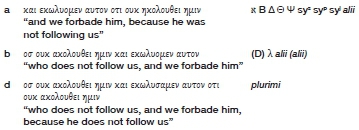
According to Metzger (1994:86) reading d is a conflation that presupposes the existence of the other two. He prefers reading a because of superior witnesses and because in reading b there has been a transposition of the last clause to bring it into proximity to its subject (with the change of οτι into οσ). However, like Hort, also Metzger forgets that sometimes minor variations may form a key to a solution. Among others Robert Stein follows Metzger.9
4. PLEA FOR THE WESTERN READING
The approach of Hort and Metzger is surely not the only one. Lagrange (1947:246) for instance gives the following text: ειδομεν τινα εν τω ονοματι σου εκβαλλοντα δαιμονια, οσ ουκ ακολουθει ημιν, και εκωλυομεν αυτον, vidimus quendam in nomine tuo eicientem daemonia, qui non sequitur nos, et prohibuimus eum, nous avons vu quelqu'un qui chassait des démons en ton nom, qui ne nous suit pas, et nous l'avions empêché. Lagrange prefers the text of von Soden (and of Tischendorf without the last phrase) to that of Westcott-Hort and Vogels. It is the text of family λ and the Latin vulgate. Lagrange interprets εκωλυομεν αυτον (nous l'avions empêché) as a past perfect (plus-que-parfait), and considers prohibuimus eum (nous l'avons empêché) of the vulgate as stronger (less anxious).10
Vincent Taylor (1966:406-407) puts forward more or less the same view of the case. According to him the Western text omits οτι ουκ ηκολουθει ημιν of the old Nestle, and inserts οσ ουκ ακολουθει ημιν after δαιμονια. This reading (see below sub 1) should be preferred to that of the W&H text, in spite of its support in a B, for the reading with οτι in 38b may be an assimilation to the text of Luke 9:49 which reads οτι ουκ ακολουθει μεθ ημων."11See the following summary.

Charles Cranfield (1966:310) joins Taylor: "Probably we should follow the Western text and omit the οτι-clause, which looks like assimilation to Luke." Maybe Lagrange and Taylor and Cranfield deserve more attention.
5. ANALYSIS OF MARK 9:38
Beforehand something must be said about the Greek witnesses and the versional evidence. As to the Greek readings, use has been made of Text und Textwert (TTW) edited by Kurt and Barbara Aland (1998:259-265). However, some uncials are not recorded in TTW.12 In addition, there may be some errors. Therefore New Testament Greek Manuscripts edited by Reuben Swanson (1995:150) has been consulted, together with other sources, including reproductions and the like.13
The following families with their symbols are used.

As to the versional evidence, the question arises in which language the versional readings will be given. According to Tjitze Baarda (1994:60), the most appropriate way in recording them would be to give verbatim quotations in the original script, but without translation this would be of little benefit for those who do not know these languages. Therefore I prefer to provide the readings in question in the language of the sources used.

Below one finds a survey of variants in Mark 9:38 (after ειδομεν τινα εν τω ονοματι σου εκβαλλοντα δαιμονια).16

According to D.05 John said: διδασκαλε ειδαμεν τινα εν τω ονοματι σου εκβαλλοντα δαιμονια οσ ουκ ακολουθει μεθ ημων και εκωλυομεν αυτον ("Teacher, we saw someone in your name driving out demons who does not follow with us, and we tried to stop him"). This sentence is well constructed: the impersonal τινα is explicated by the phrase οσ ουκ ακολουθει μεθ ημων, and the last phrase says that the disciples tried to stop that person. Jesus responds: do not stop him. It is evident that the phrases are given in the right order: someone is seen who does not follow with us, we tried to stop him, Jesus replied: do not do that. The evangelist writes the better Greek. The vetus latina followed by Augustine translates μεθ ημων with nobiscum, and understands εκωλυομεν as a perfect tense, not as an imperfectum de conatu.18 I suppose that both μεθ ημων and εκωλυομεν are presynoptic.19 The phrase qui nobiscum non it in geo1 is equivalent to ακολουθει μεθ ημων (see sys and syj hereafter sub 4).
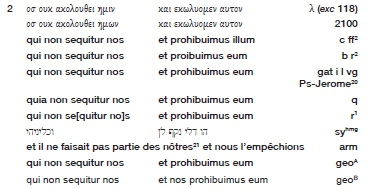
Reading 2 shows the change from (ακολουθει) μεθ ημων to ημιν. The verb ακολουθεω is usually constructed with the dative (with μετα τινοσ apart from Mark 9:38 and Luke 9:49 also in Rev 6:8 and 14:13, with οπισω τινοσ in Matt 10:38 and Mark 8:34). So here one finds a change from unusual to common. Minor changes: quia ex errore q, explicative addition of nos (ημεισ) geoB.

Like the Latin translators reading 3 interprets εκωλυομεν not as an imperfectum de conatu, with no indication as to whether the act is momentary or not: εκωλυσαμεν, we forbade him, we stopped him. Codices W 565 change ακολουθει into ηκολουθει, he was following (or he had been following). Minor changes: υμιν ex errore 346, οστισ loco οσ 2542.22
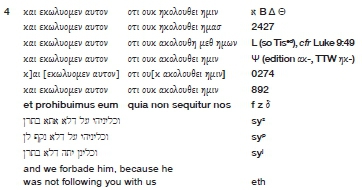
In reading 4 one finds an inversion of the two phrases: first the prohibition, thereafter the reason of it (οσ becomes οτι). As in readings 1 and 2 the prohibition says και εκωλυομεν αυτον, et prohibuimus eum. The reason is expressed by οτι ουκ ακολουθει ημιν, quia non sequitur nos. As in W 565 ακολουθει has been changed into ηκολουθει in a B Δ Θ 2427. While manuscript 0274 has a marked affinity with L.019, I read ακολουθει ημιν.23The phrase μεθ ημων in L may be a reminiscence of Luke 9:49. The phrase ερχεται οπισω ημων in sys syj is a Syriac translation of ακολουθει ημιν.24Minor change: ημασ loco ημιν 2427.

Also in reading 5 the aorist εκωλυσαμεν of reading 3 does not indicate whether the act is momentary or not: we forbade him. The words μεθ ημων in 1342 (cfr sa bo eth) may be a reminiscence of Luke.

Reading 6 combines οσ ουκ ακολουθει ημιν και εκωλυσαμεν αυτον of reading 3 with οτι ουκ ακολουθει ημιν of readings 4 and 5. This artificial and conflate reading of A Π is found in 1391 witnesses.25 Again μεθ ημων in Φ and Basil may be a reminiscence of Luke 9:49. Minor change: omission of αυτον in Bas.26 The phenomenon homoioteleuton is found in 122 witnesses. In addition to φ124 I mention explicitly 131 174 σ349 π1816. Likewise in an artificial and conflating way syh** adds οτι ουκ ακολουθει ημιν to reading 2.
7 οσ ουκ ακολουθει ημιν και εκωλυομεν αυτον οτι ουκ ηκολουθει ημιν Tis8
Finally, some critical editions provide in this part of the verse the byzantine text (with εκωλυομεν instead of εκωλυσαμεν and ηκολουθει instead of ακολουθει of TR). These are Tis8 Wss Nes3-25 Mrk.
After this survey of the succession of readings the following summary may be given.

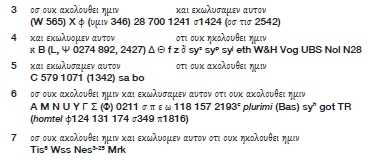
6. CONCLUDING REMARKS
First of all it has become evident that Codex Bezae D.05 provides the reading that explains the rise of the others: (ειδαμεν τινα) οσ ουκ ακολουθει μεθ ημων και εκωλυομεν αυτον, (videmus quemdam) qui non sequitur nobiscum et prohibuimus eum, (we saw someone) who does not follow with us and we tried to stop him.27 Immediately hereafter follows: Jesus said: do not stop him. The edition of Westcott and Hort gives this reading in the margin. Maybe this reading is at the same time presynoptic (see below).
The second reading (family λ and several old versions) with ακολουθει ημιν is found in Tis7 Sod Bov Sou BOC HGr. It is preferred by Taylor, Cranfield, and likewise by Ernst Haenchen (1966:327): "Die Worte 'weil er uns nicht folgt' (Nes17) könnten ein spáterer Zusatz sein." The third reading, found in (W 565) X φ 28 700 1241 1424 (2542), with εκωλυσαμεν instead of εκωλυομεν, is not found in any modern critical edition. The transposition of the two phrases in the fourth reading (a B (L) etc) is followed by W&H Vog UBS Nol N28. This means that the new Nestle (SQE15 UBS4 N281) follows W&H", and not the conjectural emendation of the old Nestle. The text behind the versions (f z δ) is not certain. The fifth reading (C 579 1071 (1342)) provides εκωλυσαμεν (as in reading 3). The artificial sixth reading has been composed out of readings 3 and 5 (conflation). The likewise artificial seventh reading seems to be a conjectural emendation of reading 6, with εκωλυομεν instead of εκωλυσαμεν and ηκολουθει instead of ακολουθει.28It is only found in critical editions (since Tis8).
The reading of Mark 9:38 in Codex Bezae can be presynoptic. I consider as presynoptic the reading that explains the rise of the readings of Matt and Mark and Luke. Apart from this Bezan reading, one finds the phrase μεθ ημων (or equivalent) in L Φ 1342 eth Basil. As has been said, it may be a reminiscence of Luke 9:49. Or rather a reminiscence of a presynoptic reading. Here are three examples (including Mark 9:38) of a supposed presynoptic reading as compared with the reading of the synoptic gospels.
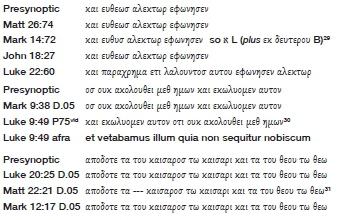
In the last example the Bezan text provides in a perfect balance a pure parallelism (more so than in the official readings of this synoptic saying): send what comes from Caesar back to Caesar and what comes from God back to God. Paraphrased: give what bears the image of Tiberius back to Tiberius and what bears the image of God back to God (= give the man back to himself, show respect to a human being). It is N28 that provides free (read uncontrolled) variants of this saying of Jesus: Luke adds τοινυν, Matt adds ουν, and Mark shows the inversion τα καισαροσ αποδοτε. All three provide καισαροσ and καισαρι without the article.32
7. METHODOLOGICAL NOTE
As to the approach of Hort, the following may be observed. It is not only that he prefers the so called Alexandrian reading (Alpha text-type) to the so called Western reading (Delta text-type), but also that he distinguishes merely three categories (α β δ), whereas one sometimes has to divide the readings into more categories (multiple main readings). The summary above presents six readings from manuscripts instead of merely three categories by Hort. Therefore the following methodological note is needed.
In 1881 Hort examined the Posteriority of Syrian readings to Western and Neutral readings shown by analysis of conflate readings, as I have shown in the foregoing pages. In 1911 Edward Ardron Hutton (1911) urged the use of what he called triple readings: he published a list of readings in which the Alexandrian and Western and Syrian authorities divide. According to Ernest Cadman Colwell (1969:27), Hutton's work is far from perfect. In a note on the same page Colwell reminds us that modern obsession with three text-types is derived from Jerome's preface to Chronicles, rather than from a study of manuscript groupings based upon readings.33 He concludes with the remark that the New Testament manuscript material (which provides a multiple of different readings) is too varied to fit into only three text-types. So Colwell speaks of multiple readings. According to Frederik Wisse (1982:29)
The multiple readings give much more detail than Hutton's tool. ... Colwell has a much better range of existing textual groups, and hence will end up with much less ambiguous results.
Nevertheless, Metzger (1994:15*-16*), in the second edition of his Textual Commentary, maintains (actually returns to) the division into three categories of witnesses: Alexandrian, Western, Byzantine.
At the Lunel Colloquium of 1994 (Hendriks 1996:235-237) I proposed a division into eight readings of Mark 5:21, with as the first και διαπερασαντοσ του ιησου εισ το περαν παλιν συνηχθη οχλοσ πολυσ προσ αυτον παρα την θαλασσαν ("When Jesus had crossed to the other shore, much people again gathered round him by the lakeside," of D.05. In the Revue Biblique (Hendriks 2005:581-587) I described six different readings of Matt 6:33 found in the fathers, with Ζητειτε δε την βασιλειαν των ουρανων και ταυτα παντα προστεθησεται υμιν ("Strive for the kingdom of heaven and all these things shall be added to you," of Justin). In the Revue Biblique (Hendriks 2007:266-271) I divided Mark 8:26 into five readings, with υπαγε εισ τον οικον σου και μηδενι ειπησ εισ την κωμην ("Go to your house and tell no one in the village", of D.05) again as being the head of the transmission. Let these examples be sufficient.
From a methodological point of view the fact of multiple readings within the same variation unit must be preferred to a theoretical division into only three categories. So Hort makes a methodological error.
BIBLIOGRAPHY
Aland, K. & Aland, B. 1995. The text of the New Testament: An introduction to the critical editions and to the theory and practice of modern textual criticism. Second Edition (paperback). Grand Rapids (MI): Eerdmans. [ Links ]
Aland, K. & Aland, B. 1998. Text und Textwert der griechischen Handschriften des Neuen Testaments (= TTW). Band 4,1,2. Das Markusevangelium. Berlin - New York: De Gruyter. ANTF 27. [ Links ]
Aland, K. & Aland, B. 2012. Novum Testamentum Graece. Begründet von Eberhard Nestle und Erwin Nestle. Herausgegeben von Barbara und Kurt Aland, Johannes Karavidopoulos, Carlo Maria Martini, Bruce M Metzger, 28. revidierte Auflage. Stuttgart: Deutsche Bibelgesellschaft [= N28]. [ Links ]
Allen, W.C. 1915. The Gospel according to Saint Mark: With introduction and notes. London: Rivingtons. OCBC. [ Links ]
Baarda, T. 1994. What kind of critical apparatus for the New Testament do we need? The case of Luke 23:48. In: B. Aland - J. Delobel (eds), New Testament textual criticism, exegesis, and early church history: A discussion of methods (Kampen: Kok Pharos, Contributions 7), pp 37-97. [ Links ]
Colwell, E.C. 1969. Studies in methodology in textual criticism of the New Testament. Leiden: Brill. NTTS 9. [ Links ]
Cranfield, C.E.B. 1966. The Gospel according to Saint Mark: An introduction and commentary: With additional supplementary notes. Cambridge: University Press. CGTC. [ Links ]
Haenchen, E. 1966. Der Weg Jesu: Eine Erklárung des Markus-Evangeliums und der kanonischen Parallelen. Berlin: Alfred Töpelmann. Sammlung Töpelmann 2,6. [ Links ]
Hendriks, W.M.A. 1996. Legons pré-alexandrines du Codex Bezae dans Marc. In: D.C. Parker, -C.-B. Amphoux (eds), Codex Bezae: Studies from the Lunel Colloquium, June 1994 (Leiden: Brill, NTTS 22), pp. 232-239. [ Links ]
Hendriks, W.M.A. 2003. Variation textuelle dans l'Evangile selon Marc (illustrée par Mc 6,33). In: C.-B. Amphoux - J.K. Elliott (eds), The New Testament text in early Christianity: Proceedings of the Lille colloquium, July 2000 (Lausanne: Du Zèbre, HTB 6), pp 349-367. [ Links ]
Hendriks, W.M.A. 2005. Brevior lectio praeferenda est verbosiori. Revue Biblique 112(4):567-595. [ Links ]
Hendriks, W.M.A. 2007. Mc 8:26: ne le dis á personne dans le village. Revue Biblique 114(2):255-272. [ Links ]
Hendriks, W.M.A. 2009. Lectio e qua caeterarum ortus facillime explicetur [Mark 1:4.5.16.28.29]. Filología Neotestamentaria 22:3-39. [ Links ]
Hendriks, W.M.A. 2011. Internal evidence of readings. Estudios Bíblicos 69:301-322. [ Links ]
Hendriks, W.M.A. 2014. The case for the primacy of the Western Text. Estudios Bíblicos 72:411-436. [ Links ]
Hort, F.J.A. 11881. The New Testament in the original Greek. Vol II, Introduction & Appendix. Cambridge - London: Macmillan. [ Links ]
Hutton, E.A. 1911. An atlas of textual criticism: Being an attempt to show the mutual relationship of the authorities for the text of the New Testament up to about 1000 AD. Cambridge: University Press. [ Links ]
Lafleur, D. 2013. La Famille 13 dans l'évangile de Marc. Leiden - Boston: Brill. NTTSD 41. [ Links ]
Lagrange, M.-J. 1947. Evangile selon Saint Marc. Paris: Gabalda et Cie. Etudes Bibliques. [ Links ]
Land, J.P.N. 1875. Anecdota Syriaca IV. Leiden: Brill. [ Links ]
Legg, S.C.E. 1935. Novum Testamentum Graece, Secundum textum westcotto-hortianum, Evangelium secundum Marcum cum apparatu critico novo plenissimo. Oxonii: Clarendoniano. [ Links ]
Lohmeyer, E. 1967. Das Evangelium des Markus: Nach dem Handexemplar des Verfassers durchgesehene Ausgabe. Göttingen: Vandenhoeck & Ruprecht. KEK 1,2. [ Links ]
Lührmann, D. 1987. Das Markusevangelium. Tübingen: Mohr (Paul Siebeck). HNT 3. [ Links ]
Metzger, B.M. 1994. A textual commentary on the Greek New Testament: A companion volume to the United Bible Societies' Greek New Testament. Second Edition. Stuttgart: Deutsche Bibelgesellschaft. [ Links ]
Plumley, J. M. & Roberts, C.H. 1976. An Uncial Text of Saint Mark in Greek from Nubia, The Journal of Theological Studies NS 27:34-45. [ Links ]
Ross, J.M. 1983. Some unnoticed points in the text of the New Testament. Novum Testamentum 25(1):59-72. [ Links ]
Stein, R.H. 2008. Mark. Grand Rapids (MI): Baker Academic. BECNT. [ Links ]
Swanson, R. 1995. New Testament Greek Manuscripts: Variant readings arranged in horizontal lines against Codex Vaticanus: Mark. Sheffield: Academic Press -Pasadena CA: William Carey International Academic Press. [ Links ]
Taylor, V. 1966. The Gospel according to Saint Mark: The Greek text with introduction, notes, and indexes. London etc: Macmillan - New York: St Martin's. [ Links ]
Westcott, B.F. & Hort, F.J.A. 1881. The New Testament in the original Greek. Vol I, Text. Cambridge - London: Macmillan. [ Links ]
Weber, R. 1975. Biblia Sacra, iuxta vulgatam versionem, editio altera emendata. Tomus I. Stuttgart: Würtembergische Bibelanstalt. [ Links ]
Wisse, F. 1982. The profile method for the classification and evaluation of manuscript evidence, as applied to the continuous Greek text of the Gospel of Luke. Grand Rapids (MI): Eerdmans. StD 44. [ Links ]
1 The words εκει (there, in that place) and αυτου (just there) have the same local meaning. Cfr Acts 18:19 εκει P74 a A D E 33 104 326 1241, αυτου B L Ψ 323 614 945 1175 1505 1739 plurimi.
2 A.02 repeats συνεδραμον at the place of συνηλθον.
3 For the shorter reading principle see Hendriks (2005, 2011).
4 Lohmeyer (1967:159): "Auch sachlich wáre ein Befehl: 'Gehe nicht in das Dorf!' unverstándlich. Wohnt der Blinde nicht im Dorf, so ist er überflüssig; steht 'sein Haus' aber im Dorf, so ist er unsinnig."
5 Explicitily only Allen (1915: 116).
6 So among others Lohmeyer (1967:158).
7 Hort reads ειδαμεν (with α as in D N Σ Ψ 346). He notes that 33 is defective.
8 According to Ross (1983:63): "this is hardly a sufficient motive for so radical an alteration."
9 Stein (2008:451) adds: "The other variants involve primarily differences in tenses and in the order of the clauses; εκωλυομεν is a tendential/conative imperfect." Precisely the order of the clauses is my main concern.
10 Lagrange (1947:247): «L'imparfait εκωλυομεν semble indiquer cette inquietude: nous l'avons empêché (Vulgate etc) serait plus ferme.»
11 Taylor's printed Greek text follows more or less the old Nestle, but with οτι ουκ ηκολουθει ημιν within square brackets.
12 For the questionable reason see Aland-Aland (1995:103).
13 Reproductions (P45 A B W Δ), microfilms (28 33 700 892), facsimilia (a B C L Θ), and editions (A C D N Π Σ Φ Ψ 0274 λ φ ε ω 565 579).
14 Using the Lexicon.
15 The Greek agrees with the Gothic: saei ni laisteib unsis, jah waridedum imma, unte ni laisteib unsis.
16 Absent witnesses: P45 P84 P88 P 33 e n t.
17 Augustine (De consensu evangelistarum 4.5), CSEL 43, 398.
18 See BDF § 326. Nor as a plusquamperfectum.
19 Luke 9:49 reads: και εκωλυομεν αυτον οτι ουκ ακολουθει μεθ ημων. BDF § 1931: "μεθ ημων not follow us, but follow [you] together with us."
20 Pseudo-Jerome (In evangelium secundum Marcum 9.38), PL 30, 616.
21 Litterally: and does not go behind us (so Baarda, by email).
22 BDF § 293: "The definite relative οσ and the indefinite relative οστισ are no longer clearly distinguished in NT."
23 See Plumley - Roberts (1976:42), with note 45: "168-70: These lines are barely legible in the photograph." Their reconstruction of the text with ηκολουθει follows Nes.
24 For syj see Land (1875).
25 I refer to Text und Textwert, herausgegeben von Aland - Aland (1998:259-265). Codex Π.041 is not mentioned, in addition L.019 reads actually ακολουθει μεθ ημων, and W.032 actually ηκολουθει.
26 Basil the Great (Moralia - Regula 19.2), PG 31, 736: ειδομεν τινα εν τω ονοματι σου εκβαλλοντα δαιμονια οσ ουκ ακολουθει μεθ ημων και εκωλυσαμεν οτι ουκ ακολουθει ημιν.
27 Latin et prohibuimus eum: and we stopped him.
28 See Lührmann (1987:166): "Tischendorfs Konjektur, die bis Nes25 übernommen war, ist in N26 und bei Greeven [HGr] aufgegeben, freilich mit unterschiedlichen Ergebnis. Die Bezeugung für die Textfassung von N26 ist zwar quantitativ gering (a B Δ Θ 0274 pc f z sy syp) und steht ebenfalls unter dem Verdacht der Beeinflussung durch Lk 9,49, kann sich aber immerhin auf a und B stützen."
29 και ευθυσ in a B L 0250 2427 2542 and seven other less known mss. The majority reads ευθεωσ instead of ευθυσ.
30 Luke 9:49 according to (sine αυτον P45vid) P75vida B L Ξ 157 579 892 1241 a b e l arm geo.
31 Accidental loss of του.
32 Nota bene: καισαρ with the article refers to the actual imperator Tiberius.
33 Concerning Jerome's preface to Chronicles I refer to Aland (1995:65-66). For the text of Jerome's preface see Weber (1975:546-547).














